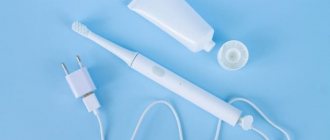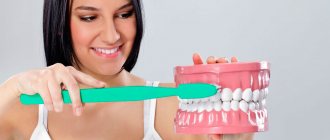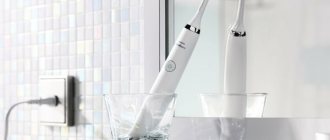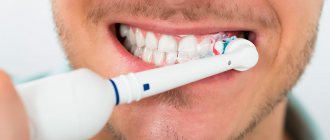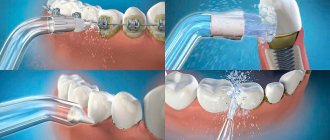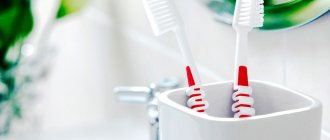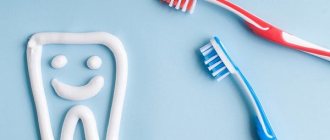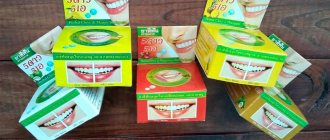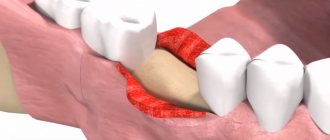High-quality teeth cleaning primarily depends not on the paste, but on the instrument with which it is carried out. A regular brush has long proven its low effectiveness, as indicated by many studies. The use of modern brushes guarantees a high level of oral cleanliness with minimal effort. Before purchasing the optimal cleaning tool, you should determine which toothbrush will be better - electric or ultrasonic, and also find out the main features and disadvantages of both tools.
Choosing the right oral care tool is key to healthy teeth
What types of toothbrushes are there?
In general, all instruments for caring for teeth and the oral cavity according to the principle of action and functions are divided, in fact, into just 2 groups - these are mechanical, that is, the most common ones, as well as electric ones, which contain a battery that leads to the movement of the head or only her bristles. Electric ones, in turn, are divided into classical (the head simply moves), sound and ultrasonic (waves are added here), as well as ionic (negatively charged ions are additionally “included” in the work, which lead to effective destruction of plaque). They all differ from each other in the degree of stiffness of the bristles, the material of the bristles, and the size and shape of the cleaning head.
Any models can also be equipped with various and original additions:
- rubber insert on the handle,
- indicator bristles,
- use of silver ions,
- multi-directional or multi-level bristles,
- textured tongue cleaning pad,
- ribbed surface for gum massage.
Each type of teeth cleaning tool has its own advantages and disadvantages. Before making a choice, you should know what a sound electric device means, what is the principle of its operation, what are the differences from other types of dental care instruments, and are there any contraindications for use.
Device and principle of operation
Such models date back to 1992. The device is a structure consisting of a handle with a built-in electric motor, a battery (or batteries) and a bristle head. The brush is called “sonic” because a microgenerator produces high-frequency waves, the vibrations of which cause the bristles to rotate and help clean plaque from teeth. Modern dental appliances of this type operate with a frequency of 500-1500 Hz and, depending on the model, are capable of 30-90 thousand vibrations per minute. Such a speed of movement, of course, is beyond the strength of a human hand.
For comparison! The number of rotations or vibrations that an innovative electric brush creates, we can do on our own with a regular hygiene product in at least 2-3 months. When brushing your teeth with a regular classic brush, you can achieve, with a lot of effort, only 250 vibrations per minute.
The bristles on the brush move in a circle, but some models use a combination of pulsating and reciprocating movements. The high amplitude of vibration creates an emulsion of saliva, water and toothpaste, which is able to penetrate into the spaces between teeth and hard-to-reach places. Thanks to this, not only a thorough cleaning of the enamel and interdental spaces occurs, but also the splitting of plaque. Many models are equipped with a timer that regulates the time spent cleaning the mouth.
Benefits and harms
Using an electric ultrasonic toothbrush on a person with a healthy mouth and unfilled teeth can be very effective. With its help, it is possible to remove soft plaque, clean the interdental spaces, and also remove partially mineralized plaque.
Harm from the use of such a device relates mainly to cases of its use in the presence of numerous dental structures, fillings, as well as a number of diseases. Therefore, it is important to consult your dentist before purchasing a device. You can visit a dental hygienist or combine a consultation with a professional cleaning. The specialist will definitely tell you whether it is necessary to use an ultrasonic brush and whether it will cause harm.
Advantages of the models
Compared to mechanical models, sound ones have both pros and cons. Due to active movements, dynamic fluid flow and wave vibrations, the main advantages of modern models include the following:
- high efficiency in cleaning tooth enamel compared to any other models,
- effective removal of deposits even from under the gums, from very narrow gaps between teeth, that is, very deep cleansing of the entire oral cavity,
- ease of use,
- light massage effect on the gums,
- can be used for teeth with sensitive enamel,
- economical consumption of toothpaste,
- ergonomic design,
- allowed for use in children,
- reliability of the device and a fairly long service life.
This type of device is ideal for coffee and tobacco lovers. These products darken the enamel, while sound vibrations help lighten the tooth enamel by one or two tones. It is impossible to achieve such whitening with other, especially classic models.
Contraindications to the use of devices
The disadvantages include the high price, which, however, is compensated by long-term operation. Also, these models are not recommended for use by people with dental health problems.
Despite their safety and many advantages, brush models have a number of contraindications for daily use:
- pregnancy, especially in the first trimester,
- diseases of the oral cavity (hypertrophic gingivitis, periodontitis),
- high tooth mobility,
- surgical interventions in the oral cavity,
- acute and chronic inflammatory processes of tooth roots,
- demineralization of enamel,
- severe tooth wear,
- presence of a pacemaker,
- neoplasms of various types in the mouth,
- bruxism,
- defects of the dental neck.
It is not recommended to use products with a large number of fillings, implants, crowns, veneers, bridges and dentures. A high-frequency sound wave has a negative effect on artificial products, causing not only them, but also premature destruction of fixation compounds.
Which paste is best to use?
An important role in daily hygienic care of the oral cavity is played by toothpaste , which complements the action of a sonic brush.
To avoid damage to tooth enamel, non-abrasive toothpastes should be used on an ongoing basis.
It is not recommended to use products with a high abrasiveness index on a daily basis in conjunction with electrical devices.
Because this can lead to increased tooth sensitivity and provoke the development of caries.
Comparison of a sonic brush with a conventional mechanical one
The regular toothbrush has changed very little over its more than 2,000-year existence and also has its advantages. These include compactness and simplicity, acceptable (and one might even say very low) price, absence of contraindications, the possibility of frequent replacement, since even the cheapest option will be available to low-income people, low trauma to teeth and gums when used correctly, cost-effectiveness .
But despite all the advantages, a mechanical brush is significantly inferior to a sonic brush in the quality of cleaning teeth and gums. The advantages of sonic toothbrushes include high cleaning power with a minimum of movements. In fact, a person does not need to do anything - just move the brush along the teeth, and it will do everything on its own. Under the influence of waves, plaque splits even in hard-to-reach places. If the operating rules are followed, the device can be used for a long time without losing its functions.
Dentist reviews
Many innovative methods can solve the problem of insufficient cleansing of the oral cavity and improve the condition of teeth.
However, it should be understood that it is impossible to quickly achieve the desired result without the participation of a dentist.
Despite the fact that sonic brushes are particularly popular, I do not recommend using them without first consulting a doctor, since the use of these devices does not always have a positive effect on the patient’s health.
Patients often ask me questions about the benefits and possible contraindications to using sonic toothbrushes.
To this I always answer: you can and should use them, because with their help you can prevent the appearance of caries, tartar and inflammatory processes.
Of course, before purchasing, you need to visit a specialist and only after an examination choose a suitable, and most importantly safe, model.
Sonic or electric toothbrush – which is better?
Both sonic and electric with a rotating head are both electric. They operate from a charged battery or batteries. The fundamental difference between a sonic brush is the frequency of movement of the bristles and the participation in cleaning waves (bristles + speed + waves). We can say that a sonic electric brush is a more advanced model of an electric one.
When electric brushes appeared, many began to abandon the classic models in favor of them - the rotational movements that an electric toothbrush makes provide good quality in cleaning teeth from plaque. But over time, it became clear that despite all its innovation, this method of daily care is still not 100% effective in a number of situations - food particles still settle between the teeth and become clogged under the gums. This forced scientists and developers to improve the electric brush model - this is how first the ultrasonic and then the sonic brush appeared (see the difference between the latter two below).
What makes a sonic toothbrush different is the presence of sound waves. The combination of high-speed rotational movements and sound vibrations contributes to the greatest effectiveness of hygiene measures. The softened plaque peels off the tooth and is washed away even from the most previously inaccessible places. For the oral cavity, devices of this type are less traumatic, and therefore preferable.
Important! Unlike a standard electric toothbrush, a sonic toothbrush has a larger list of contraindications - it cannot be used if you have dentures, braces, implants, or if you have electrical devices, such as pacemakers.
Consumer Reviews
Below are some reviews from customers and dentists. If you have something to say, leave your feedback in the comments below the article, it will be useful to our readers.
Marta Vasilyeva, Bryansk.
My first experience using a sonic brush was very unsuccessful: after not working for even two days, the device broke down and had to be returned to the store.
After some time, I returned to the topic of sound models and finally purchased a waterproof brush from Xiaomi.
At first the sensations were unusual, but after a week of use I realized that I would never return to regular brushes. I didn’t connect the device to the phone, I don’t think it’s necessary.
Kristina Zvonkovich, Saratov.
My three-year-old son was completely indifferent to brushing his teeth, as well as to toothbrushes.
Because of the baby's reluctance to brush his teeth, we became regular visitors to the dental office.
This continued until the doctor advised me to purchase a children's sonic toothbrush, which should interest the child.
We chose the CS-562 Junior model from CS Medica and for 5 months now our son has been happily brushing his teeth twice a day. The brush is interesting, light, he likes it.
Ivan Suslov, Petrozavodsk.
My wife and I switched to electric toothbrushes a long time ago, as they are more convenient to use and they clean much better than classic models.
In honor of the holiday, I gave my wife a CS Medica CS-333 in white - a very successful and sophisticated device.
The brush operates in five modes, runs on a battery (the charge lasts a long time), the quality is simply excellent! After 2 months of use, we couldn’t find any downsides, everything works great.
Difference between sonic and ultrasonic models
Both devices work virtually similar to each other, but an ultrasonic electric toothbrush produces ultrasonic waves that are longer in length. Compare, in sonic brushes there are about 30 thousand sound vibrations per minute, and in ultrasonic brushes this number starts from 100 million. Increasing the frequency and speed of rotation by several orders of magnitude has both its advantages and significant disadvantages.
Thanks to the increased power, toothbrushes with ultrasound acquire a number of advantages; the bristles rotating at ultrasonic speed carefully remove soft deposits and destroy harmful microorganisms; penetration of ultrasound to a depth of 4 mm helps remove plaque in places inaccessible to other types of devices; ultrasonic waves can have a therapeutic effect on the periodontal groove, shallow periodontal canals, interdental spaces, high-frequency ultrasound helps to release healing components from toothpaste, thereby helping to strengthen the enamel.
Ultrasonic models perform antibacterial and disinfecting functions and stimulate metabolic processes. Their action can be compared to a portable scaler, which periodontists use to treat gum disease and clean plaque. But along with the fact that such enhanced hygiene procedures are not carried out every day in a dental office, ultrasonic brushes, when used daily, can in some cases cause harm, especially in the presence of oral diseases. At a high oscillation frequency, the amplitude of movement of the bristles becomes extremely small, so the necessary sweeping movements are not carried out, as is done in sound analogues. Therefore, sound devices are still considered more effective.
Pros of ultrasonic brushes
Ultrasonic models offer numerous advantages. Pros of the brush:
- direct effect on pathogenic microflora. At the same time, the growth of bacteria is suppressed, the development of caries slows down, and the process of soft tissue regeneration is accelerated. The treatment of some diseases is compatible with the use of a brush;
- efficiency. The devices cope with smokers' plaque and hard tartar, which previously could only be cleaned in a dental office. The effectiveness of the device is also indicated by the advice of real people who have experienced the effects of the device on themselves;
- impact on hard-to-reach areas. Ultrasonic waves affect the most remote and deep areas of the tooth, destroying plaque and disinfecting tissue;
- Possibility of use in people with braces and dentures. With the help of such a brush, it is possible to achieve maximum cleanliness of all parts of the structure;
- saving toothpaste. Ultrasonic models whip up a much larger volume of foam from a minimal amount of toothpaste.
In addition to the above, it is important to note the safety of the brushes. They do not adversely affect tooth enamel, making them the best option for people with sensitivity. Thus, the differences between such a device and a traditional brush are fundamental.
Best sonic toothbrush
Panasonic and Philips have high ratings in the dental products market. The first provides models with a standard set of functions for both home use and travel. Panasonic EW-DE92 is also available, equipped with an ionization function. Prices for electric brushes of the sonic type start from 7 thousand rubles. The second company (Philips) offers an impressive range of devices with a wide variety of functions, the cost of which ranges from 6-13 thousand rubles.
The manufacturer CS Medica produces reliable models with good performance indicators and several cleaning modes, while the price is an order of magnitude lower than that of the leaders. Sound devices from Omron, Xiaomi and Hapica have proven themselves well. All devices operate on the same principle, but differ in cost, power, functionality and design.
How to choose a sonic toothbrush
Stores today sell a wide range of teeth cleaning tools to suit every taste and budget. But before choosing a model, you should visit a dentist who will diagnose your oral cavity. After the examination, the specialist will be able to give recommendations on choice, taking into account the patient’s age, oral health, and the presence of contraindications. Before purchasing, you should also familiarize yourself with the technical characteristics, advantages and disadvantages of the selected model. Important points to note are the following:
- the number of vibrations of the fibers - the more there are, the higher the quality of cleaning,
- charging type: a device with batteries is not only more convenient, but also much more economical than analogues with batteries,
- hardness: it is best to pay attention to models with medium hardness, in this case the risk of damage to the enamel and mucous membrane is minimized,
- head shape: smooth and round with synthetic hairs is considered the most preferable,
- manufacturer: by giving preference to trusted companies, you can be sure of the high quality and reliability of the device.
When purchasing, you must remember that cost is not a priority indicator. You should choose based on your dentist’s recommendations and your preferences. It would be a good idea to read the reviews of those who already use such models. Most often, the price is inflated due to the presence of various functions that in reality turn out to be not very necessary. It is best to buy from retail outlets that specialize in selling such goods. In addition, it is in such stores that they give a long warranty on their products.
For your information! Sonic electric brushes can be used by children over three years old, but when purchasing, you need to focus on devices designed specifically for children of this age.
How to use a sound device correctly
To avoid unwanted consequences when using a sonic electric brush, you must follow simple recommendations:
- for the purpose of habituation, increase the rotation speed gradually over 14 days,
- to prevent the spread of bacterial microflora, removable nozzles must be changed every three months,
- The greatest effect is achieved by brushing your teeth twice a day,
- use a small amount of paste,
- The duration of the procedure should not exceed 3 minutes.
The sequence of actions when brushing your teeth will be as follows:
- check the functionality of the device, it must be connected and charged,
- mentally divide the jaw into three parts, sequentially treat each zone for about 30 seconds until the timer ends. You cannot press on the device, that is, brush your teeth without effort - it will do everything for you, you just need to move it along the row,
- during manipulations, clean hard surfaces with a slight grip on the gums,
- after completing the procedure, turn off the device,
- rinse your mouth, washing away food particles and plaque removed from teeth,
- Rinse the brush head well under running water.
When the brush is turned on, the bristles move independently, so there is no need to actively move the brush while cleaning the oral cavity.
